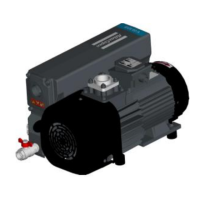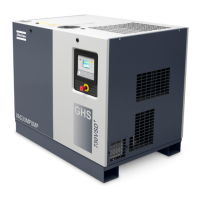N = shaft input of the vacuum pump in kW.
Δt = temperature increase of the incoming ventilation air in the vacuum pump
room in °C
▪ Make sure all piping connections from the pump to the point of use are leak
tight and secure. Leaks add load to the vacuum pump. They decrease the
available pump capacity and spoil the attainable ultimate pressure. All welds
must be vacuum compatible.
▪ Vacuum rated isolation valves must be used. Compressed air valves and
vacuum valves differ in their sealing characteristics and compressed air valves
may leak in vacuum applications.
▪ All piping should be as straight as possible with non-restrictive diameters.
Elbows, bends, tees and tapers should be used only when absolutely
necessary.
▪ Keep plumbing and system free of fluids, water, dirt, and debris that are not
part of the process. These can cause obstructions in the vacuum flow through
the piping and can reduce available pumping capacity.
▪ Exhaust piping should be installed in such a manner that it does not create
additional back pressure on the vacuum pump. Also, the exhaust piping
should be installed sloping away from the vacuum pump.
▪ A recommended alternative is the use of a drip leg with drain point provision,
to prevent condensate from running back into the fluid reservoir.
▪ Take extreme care in selecting the proper inlet filtration system for the vacuum
pump. Liquids, solids and abrasive powders must be prevented from entering
the vacuum pump to prevent mechanical failure or reduced lifetime. Inlet
filtration must be installed on every pump. The potential for particulate
contamination in rough vacuum applications is significant. The particle micron
retention of the filter element must be smaller than the smallest possible
particle load. Also, the inlet filter should be mounted in such a way to prevent
particles from falling into the inlet of the vacuum pump during cleaning or
changing of the filter element.
▪ If there is a risk for liquids to be drawn into the vacuum system, a liquid
separator should be used to separate these liquids from the incoming air. In
applications where there is significant amount of liquid, consult us.
▪ Keep the vacuum pump room dry and free from contamination.
▪ Follow recommended lubricant change schedules in normal applications (air)
and watch closely the condition and appearance of the fluid in chemical or
harsh applications. Check the leak rate of the system by pumping down to the
ultimate pressure and then valve off the vacuum pump. Monitor the pressure
rise over a period of five or ten minutes and record this rate of rise for future
reference. This value is a good tool to have if you believe there are pump or
system problems. Compare new value with the original.
▪ When pumping condensable vapours and particulates, more frequent fluid
changes are required to maintain pump life. Consult us for types and styles of
filtration units.
▪ Be sure there is no back pressure on the exhaust line of the vacuum pump.
Vacuum pumps are not specifically designed to compress exhaust gas above
atmospheric pressure. Significant back pressure can overheat the pump and
cause motor overloading. Back pressure on the pump should not exceed 0.15
bar(e) under normal operating conditions.
Installation
12/2021 - ©Atlas CopcoPage
566996022430_C

